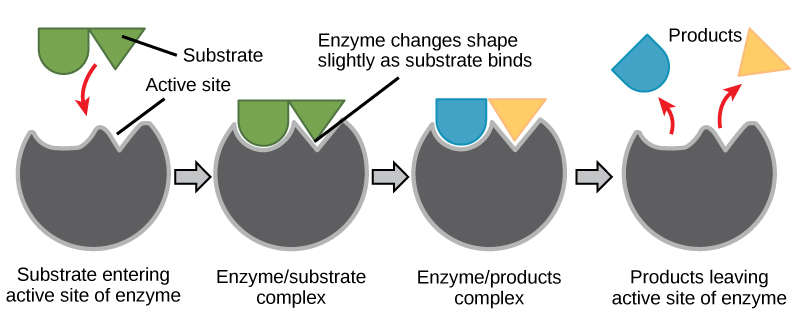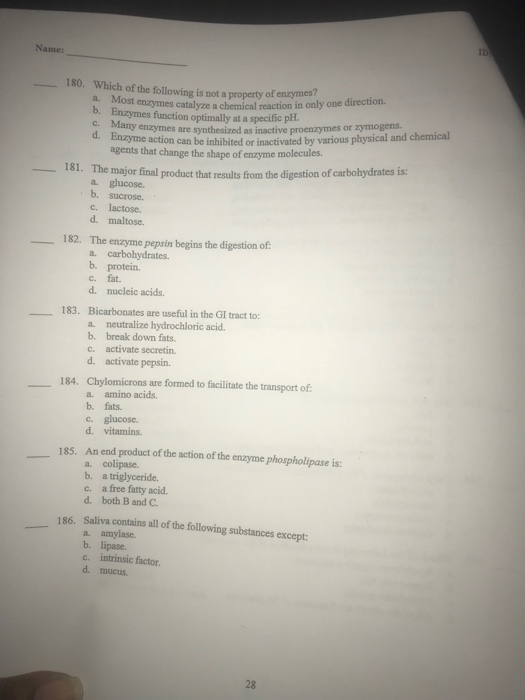Enzymes work under mild conditions. Because enzymes are specific and speed only one type of reaction.

Solved Question 6 2 Pts Which Of The Following Is True About Chegg Com
More often than not its safe to assume that a single enzyme tends to catalyze just one reaction or a set of closely-related reactions.

. E enzymes operate under a wide range of temperatures and pH. Therefore they catalyze both spontaneous and non spontaneous by the same amount meaning they do nothing to change the thermodynamics of a reaction energy of. Reactions catalyzed by most enzymes tend to go predominantly in one directionC.
All enzymes promote only anabolic reactions. Most enzymes catalyze a chemical reaction in only one direction. Enzymes can catalyze reactions through a variety of mechanisms.
C enzyme activities can often be regulated. A fundamental task of proteinsis to act as enzymescatalysts that increase the rate of virtually all the chemical reactions within cells. A enzymes show very little specificity for their substrates.
156 157 According to the induced-fit model for enzymes the binding of substrate to the active site alters the structure of the. The enormous catalytic activity of enzymes can perhaps best be expressed by a constant k cat that is variously referred to as the turnover rate turnover frequency or turnover numberThis constant represents the number of substrate molecules that can be converted to product by a single enzyme molecule per unit time usually. Enzymes can destabilize bonds within the substrate.
A comparison between the two pathways. A matched stage of the glucose oxidation with the amount of ATP molecules produced from one molecule of glucose. Conformational changes in the enzyme upon substrate binding can bring reactive groups closer together or orient them so they can react.
Although RNAs are capable of catalyzing some reactions most biological reactions are catalyzed by proteins. Many drugs are manufactured that tend to bind to an enzymes active site more quickly than the substrate the enzyme normally binds. They can catalyze reactions in both a forward and reverse direction.
Some of these include. Agents that change the shape of enzyme. Phosphoryl transfer during the AK reaction only occurs after the closing of an open lid structure in the enzyme through the catalysis by approximation mechanism Figures 721 and 722.
So the answer is option A View the full answer. 155 156 An increase in the affinity of an enzyme for its substrate will increase the reaction rate. As these enzymes catalyse the backward reactions too they are part of Gluconeogenesis pathway.
Some enzyme-catalyzed reactions always go in the same direction in a live cell eg. All enzymes promote only catabolic reactions B. Because enzymes have a specific tertiary structure which defines the 3D shape of the active site.
Chapter 04 - Cellular Metabolism 18. Enzymes therefore allow scientists to control the exchange of atoms mechanically as explained by Science Daily. Many enzymes are synthesized as inactive proenzymes or zymogens.
What type of chemical reactions do kinases catalyze. Usually enzymes catalyze only a single type of reaction and often they work only on one or a few substrate compounds. D enzymes reaction rates are generally slower than other chemical catalysts.
This means that only a substrate with a complimentary shape to the active site can bind to it and form an enzyme-substrate complex. For example hydroxide ions can catalyze the formation of double bonds and also the hydrolysis of esters. Charge specificity --- positively-charged amino.
Enzymes can work in bidirection or both the directions in a chemical reaction. Reactions of citric acid cycle RNA polymerase and others go in either direction depending on circumstances for example some enzymes of glycolysis are also involved in the reverse pathway that makes glucose. Kinases are apart of the Transferases in.
Enzyme action can be inhibited or inactivated by various physical and chemical a. Enzymes function optimally at a specific pH. One way researchers have done this is by.
Enzymes catalyze chemical reactions by first binding to molecules and then lining them up in ways that increase the probability of the molecules exchanging atoms when they collide. Most enzymes only catalyze reactions in one direction. Which of the following is not a property of enzymes.
153 154 An increase in temperature increases the potential energy of molecules. This causes an exclusion of water molecules that brings the substrates in proximity to each other and effectively lowers the energy barrier for the. As for reasons why a reaction might go in one direction only.
Enzymes are mosly made up of proteins and help to increase the reaction rate by catalysing the chemical reactions. We as outside observers can thus tell after-the-fact that many enzymes---though not all of them---are typically named for how they act This is due to. Enzymes catalyze both forward and reverse reactions by the same amount.
Chemical catalysts can react with a variety of substrates. B enzymes catalyze reactions in only one direction. Why can enzymes only catalyse one specific reaction.
Enzymes are potent catalysts. What quality allows the drug. All enzymatic reactions are reversible and produce equal amounts of products in both directions D.
Ways That Enzymes Catalyze Reactions. Most metabolic enzymes can only catalyze a reaction in a forward direction False. In the absence of enzymatic catalysis most biochemical reactions are so slow.
Except three enzymes of Glycolysis Hexokinase PFK-I and Pyruvate kinase all catalyse reversible reactions. The Central Role of Enzymes as Biological Catalysts. Answered by Jasmine M.
154 155 Most enzymes only catalyze reactions in one direction.

How Many Different Chemical Reactions Can A Single Enzyme Catalyze Socratic

Biochemistry Review Which Of The Following Is An Organic Compound A Waterc Oxygen B B Sugard D Table Salt Ppt Download

Solved Name 180 Which Of The Following Is Not A Property O Chegg Com

Solved Question 6 2 Pts Which Of The Following Is True About Chegg Com
0 Comments